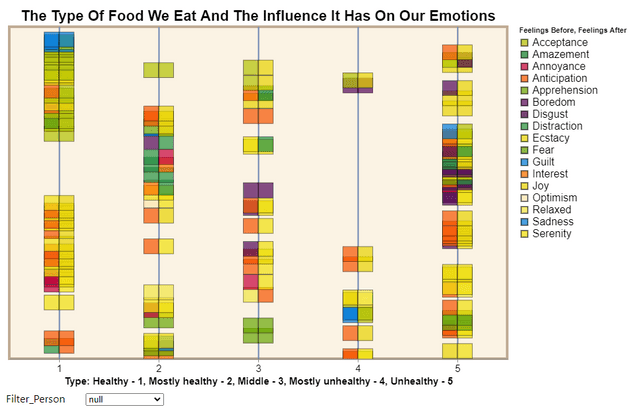Authors: Cassidy Creasy, Brian Du, Macks Tam, and Tian Xia
💻 Dataset and Source Code of interaction visualizations: GitHub
Project Summary
In this project, we went through a full pipeline of data collection, cleaning/processing/analyzing, visualization, and reporting. We collected data based on our food consumption for a week and cleaned/processed/analyzed the collected data via Python Pandas. We built interactive visualization via Python Altair and wrapped up the project with reports based on our data analysis and visualization.
Research Questions:
- What impact does our feelings have on the type of food we eat and the feelings we have after?
- What relationships exists between eating healthy and the money we spend on food?
- How do the feelings from eating at regular mealtimes differ from the feelings for eating at irregular times.
Data Attributes Collected:
- Name of food eaten
- Time of meal
- Feelings before and after eating
- Source of food
- Price of food
- Type of food (1-5)
Visualization 1 – Healthiness of Food and Emotions before and after Eating
This visual is a great tool in drilling down to identify individual habits as well as a broad overview of what the four of us tend to eat relative to our emotions. While exploring ideas for our topic, we collectively agreed that food plays an important role in our lives. It provides the nutrients we need to grow and survive, and in this day and age, it is also a source of pleasure and comfort. Here we asked the question, “What impact does our feelings have on the type of food we eat and the feelings we have after”? Through this research question, we looked to answer what sort of relationship exists between our emotions and the level of food we decide to consume. As simple as it may seem, we all participate in eating multiple times a day. By recording our self-evaluated emotions before and after eating, as well as the type of food we ate, we were able to graph this data into the graph you see below. The type of food is defined on a scale between 1-5 where 1 represents healthy food, and 5 is unhealthy. This is further defined in our data collection phases where we listed some of our most commonly eaten foods on this scale to refer back to while recording data. This data is valuable to then reflect on the habits we may have formed in relation to our emotions at the time.
Screenshot of Interactive Visualization 1:
Design Sketch of Interactive Visualization 1:
Visualization 2 – Emotions Before and After Eating during Regular and Irregular Times
How do our feelings from eating at regular mealtimes differ from the feelings eating at irregular times? From our visualization we can tell there are changes to our feelings when eating at irregular times. Most of these feelings end up being more so negative emotions. This may be due to the problems or issues that are causing us to eat at a different time. While this answers our question it is not necessarily 100% accurate. Some of us snack often and thus ate throughout the day so our emotions during eating were different. Some of us ate at a specific schedule and when we deviated, felt negative emotions such as annoyance or sadness. We also all admitted after collecting the data we were a little discouraged on how much we ate, and how unhealthy a lot of it was. Another issue to keep in mind is we are currently in lock down and thus might be more accessible to eating when we want. When not in lock down and we are at work or school for the entire day how does the data set change? Many questions can be brought up on how to make the data more accurate, but with the data we collected we can see there are mood changes when eating at irregular times. With more studies this could help students with mental health. Many students in university struggle with mental health. If there is a potential correlation of eating at scheduled times and improvements to our feelings, different solutions could be implemented to improve student mental health. For example, maybe no classes from 12 – 1 to give students actual time to eat lunch. While it may not be a massive improvement, any step towards bettering mental health is important. Hopefully our data inspires others to study eating and how it affects our feelings.
Screenshot of Interactive Visualization 2:
Design Sketch of Interactive Visualization 2:
References
- Official documentations of Python Pandas
- Official documentations of Python Altair
- Emotions are measured based on the Emotion Wheel



